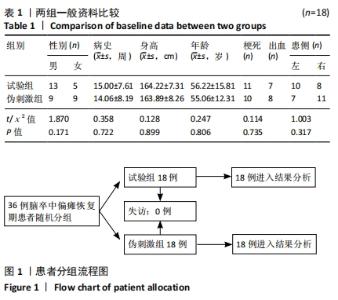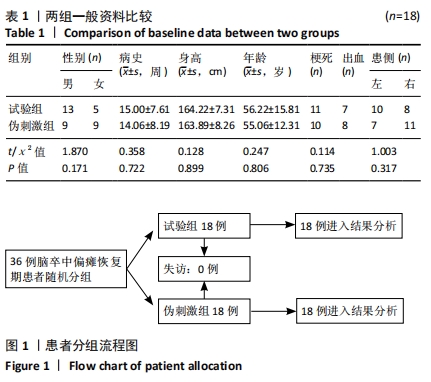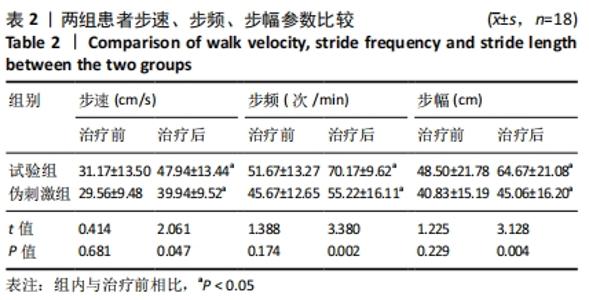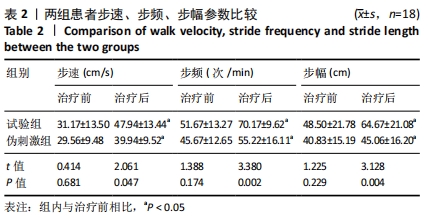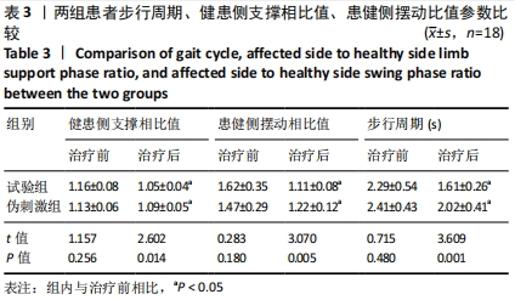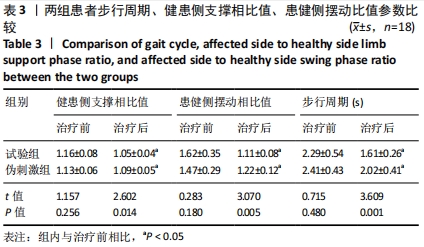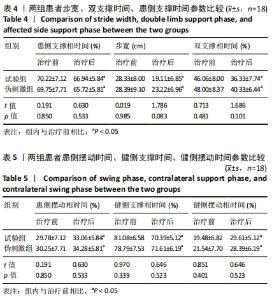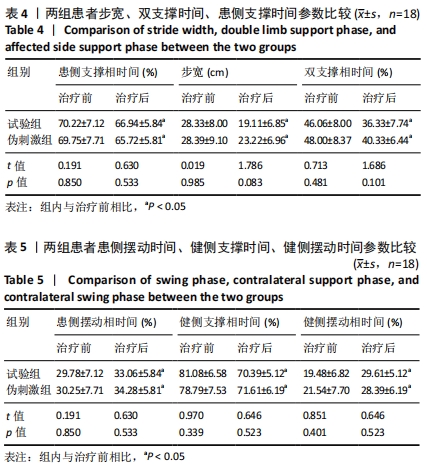Chinese Journal of Tissue Engineering Research ›› 2022, Vol. 26 ›› Issue (5): 762-767.doi: 10.12307/2022.124
Previous Articles Next Articles
Three-dimensional gait analysis of low-frequency repetitive transcranial magnetic stimulation for post-stroke hemiplegia
Shan Sharui, Huang Xuming, Zhang Mingxing, Wang Xiukun, Zheng Xiang, Bao Sairong, Hong Feng
- The First Affiliated Hospital of Guangdong Pharmaceutical University, Guangzhou 510080, Guangdong Province, China
-
Received:2021-03-04Revised:2021-03-13Accepted:2021-04-10Online:2022-02-18Published:2021-12-01 -
Contact:Huang Xuming, Chief physician, The First Affiliated Hospital of Guangdong Pharmaceutical University, Guangzhou 510080, Guangdong Province, China -
About author:Shan Sharui, Master, Attending physician, The First Affiliated Hospital of Guangdong Pharmaceutical University, Guangzhou 510080, Guangdong Province, China -
Supported by:the Young Innovative Talent Project of Guangdong Provincial Department of Education, the Young Innovative Talent Project Innovative Strong School Project of Guangdong Pharmaceutical University for Young Innovative Talents, No. 2017KQNCX109 (to SSR); a grant from the First Affiliated Hospital of Guangdong Pharmaceutical University, No. 201405 (to SSR); the Education and Teaching Research and Reform Project of the First Affiliated Hospital of Guangdong Pharmaceutical University, No. 2020JX06 (to SSR)
CLC Number:
Cite this article
Shan Sharui, Huang Xuming, Zhang Mingxing, Wang Xiukun, Zheng Xiang, Bao Sairong, Hong Feng. Three-dimensional gait analysis of low-frequency repetitive transcranial magnetic stimulation for post-stroke hemiplegia[J]. Chinese Journal of Tissue Engineering Research, 2022, 26(5): 762-767.
share this article
Add to citation manager EndNote|Reference Manager|ProCite|BibTeX|RefWorks
| [1] SABUT S, SUBUDHI AK, DASH M. Automated segmentation and classification of brain stroke using expectation maximization and random forest classifier. Biocybernetics and Biomedical Engineering, 2019;40(1):277-289. [2] 孙海欣,王文志.中国 60 万人群脑血管病流行病学抽样调查报告[J].中国现代神经疾病杂志,2018,18(2):83-88. [3] FEIGIN VL,NGUYEN G, CERCY K, et al. Global, Regional, and Country-Specific Lifetime Risks of Stroke, 1990 and 2016. N Engl J Med. 2018; 379(25):2429-2437. [4] CHOI PK, CHUNG JY, LEE SJ, et al. Recurrent cerebral microbleeds with acute stroke symptoms: a case report. Medicine (Baltimore). 2018; 97(39):e12480. [5] SHINDE K, GANVIR S. Effectiveness of trunk proprioceptive neuromus-cular facilitation techniques after stroke: a meta-analysis. Natl JMed Allied Sci. 2014;3(3):29-34. [6] BARKER AT, JALINOUS R, FREESTON IL. Non-invasive magnetic stimulation of human motor cortex. Lancet. 1985;1(8437):1106-1107. [7] LIN DJ, FINKLESTEIN SP, CRAMER SC. New directions in treat‐ments targeting stroke recovery. Stroke. 2018;49(12):3107-3114. [8] LEFAUCHEUR JP, ANDRÉ-OBADIA N, ANTAL A, et al.Evidence-based guidelines on the therapeutic use of repetitive transcranial magnetic stimulation (rTMS). Clin Neurophysiol. 2014;125(11):2150-2206. [9] LONG H, WANG H, ZHAO C, et al. Effects of combining high and low-frequency repetitive transcranial magnetic stimulation on upper limb hemiparesis in the early phase of stroke. Restor Neurol Neurosci. 2018; 36(1):21-30. [10] 周哲,沈夏锋,熊莉,等.运动前区高频重复经颅磁刺激对脑卒中上肢功能康复的疗效[J].中国康复理论与实践,2020,26(6):697-702. [11] 刘阅,王晓阳,张长龙,等.低频重复经颅磁刺激改善脑卒中后上肢痉挛的任务态功能磁共振研究[J].中国康复理论与实践,2018, 24(7): 828-833. [12] SCHULZE L, WHEELER S, MCANDREWS MP, et al. Cognitive safety of dorsomedial prefrontal repetitive transcranial magnetic stimulation in major depression. Eur Neuropsychopharmacol. 2016;26(7): 1213-1226. [13] 中华医学会神经病学分会,中华医学会神经病学分会脑血管病学组.中国各类主要脑血管病诊断要点2019[J].中华神经科杂志,2019, 52(9):710-715. [14] WASSERMANN EM. Risk and safety of repetitive transcranial magnetic stimulation: report and suggested guidelines from the international workshop on the safety of repetitive transcranial magnetic stimulation.Electroencephalogr Clin Neurophysiol. 1998;108(1):1-16. [15] 郭燕婷,范魏魏,张海峰.髋周平衡取穴对缺血性卒中后偏瘫步态的影响[J].新中医,2020,52(4):135-138. [16] 陈党红,黄培新.脑卒中后肌张力增高的基础及中西医临床研究现状[J].中国临床康复,2004(16):3096-3098. [17] 胡菱,赵冬琰.中风后痉挛性偏瘫中西医研究进展[J]. 中西医结合心脑血管病杂志,2016,14(7):729-733. [18] LEFAUCHEUR JP, ALEMAN A, BAEKEN C, et al. Evidence-based guidelines on the therapeutic use of repetitive transcranial magnetic stimulation (rTMS): An update (2014–2018). Clin Neurophysiol. 2020;131(2): 474-528. [19] CHUNG CL, MAK MK. Effect of Repetitive Transcranial Magnetic Stimulation on Physical Function and Motor Signs in Parkinson’s Disease: A Systematic Review and Meta-Analysis. Brain Stimul. 2016; 9(4):475-487. [20] LATORRE A, ROCCHI L, BERARDELLI A, et al. The use of transcranial magnetic stimulation as a treatment for movement disorders: A critical review. Mov Disord. 2019;34(6):769-782. [21] VOLZ LJ, GREFKES C. Basic principles of rTMS in motor recovery after stroke//Platz T. Therapeutic rTMS in Neurology. Cham: Springer. 2016: 23-37. [22] PASCUALLEONE A, AMEDI A, FREGNI F, et al. The plastic human brain cortex. Ann Rev Neurosci. 2005;28(28):377. [23] MAEDA F, KEENAN JP, TORMOS JM, et al. Modulation of corticospinal excitability by repetitive transcranial magnetic stimulation. Clin Neurophysiol. 2000;111(5):800-805. [24] 万青,吴伟,刘慧华,等.脑卒中患者偏瘫步态的时空及关节运动学参数分析[J].中国康复医学杂志,2014,29(11):1026-1030. [25] 励建安,孟殿怀.步态分析的临床应用[J].中华物理医学与康复杂志,2006,28(7):500-503. [26] YANG DJ, PARK SK, KANG JI, et al. Effects of changes in posturalalignment on foot pressure and balance of patients with stroke. J Korean Phys Ther. 2014;26. [27] 娄必丹,章薇,刘智,等.张力平衡针法改善脑卒中痉挛瘫痪患者残损功能的临床评价[J].中国针灸,2010,30(2):89-92. [28] VAZ PG, SALAZAR APDS, STEIN C, et al. Noninvasive brain stimulation combined with other therapies improves gait speed after stroke: a systematic review and meta-analysis. Top Stroke Rehabil. 2019;26(3): 201-213. [29] XIE YJ, CHEN Y, TAN HX, et al. Repetitive transcranial magnetic stimulation for lower extremity motor function in patients with stroke: a systematic review and network meta-analysis. Neural Regen Res. 2021;16(6):1168-1176. [30] LI Y, FAN J, YANG J, et al. Effects of Repetitive Transcranial Magnetic Stimulation on Walking and Balance Function after Stroke: A Systematic Review and Meta-Analysis. Am J Phys Med Rehabil. 2018;97(11): 773-781. [31] WANG RY, WANG FY, HUANG SF, et al. High-frequency repetitive transcranial magnetic stimulation enhanced treadmill training effects on gait performance in individuals with chronic stroke: A double-blinded randomized controlled pilot trial. Gait Posture. 2019;68: 382-387. [32] PUNDIK S, MCCABE J, SKELLY M, et al. Association of spasticityand motor dysfunction in chronic stroke. Ann Phys Rehabil Med. 2019; 62(6):397-402. [33] Rastgoo M, Naghdi S, Nakhostin Ansari N, et al. Effects of repetitive transcranial magnetic stimulation on lower extremity spasticity and motor function in stroke patients. Disabil Rehabil. 2016; 38(19):1918-1926. [34] Naghdi S, Ansari NN, Rastgoo M, et al. A pilot study on the effects of low frequency repetitive transcranial magnetic stimulation on lower extremity spasticity and motor neuron excitability in patients after stroke. J Bodyw Mov Ther. 2015;19(4):616-623. [35] Rodacki AL,Souza RM,Ugrinowitsch C,et al.Transient effects of stretching exercises on gait parameters of elderly women. Man Ther. 2009;14(2):167-172. [36] Lindow J, Domin M, Grothe M, et al. Connectivity-based Predictions of Hand Motor Outcome for Patients at the Subacute Stage after Stroke. Klin Neurophysiol. 2016;47(2):103-105. [37] Boddington LJ, Reynolds JNJ. Targeting interhemispheric inhibition with neuromodulation to enhance stroke rehabilitation. Brain Stimul. 2017;10(2):214-222. [38] Rehme AK, Eickhoff SB, Wang LE, et al. Dynamic causal modeling of cortical activity from the acute to the chronic stage after stroke.Neuroimage. 2011;55(3):1147-1158. [39] Ueda R, Yamada N, Abo M, et al. MRI evaluation of motor function recovery by rTMS and intensive occupational therapy and changes in the activity of motor cortex. Int J Neurosci. 2020;130(3):309-317. |
| [1] | Chen Keyi, Wang Dingxuan, Zhang Mengyao. Low-load compression training of the extremities influences surface electromyography and isokinetic flexor and extensor strength of core muscles [J]. Chinese Journal of Tissue Engineering Research, 2022, 26(17): 2744-2748. |
| [2] | Yang Chen, Feng Ru, Zhou Zhipeng, Wan Xianglin, Qu Feng. Effects of knee sleeve on perceived pain and lower extremity kinematics and kinetics in male and female runners with patellofemoral pain [J]. Chinese Journal of Tissue Engineering Research, 2022, 26(17): 2749-2755. |
| [3] | Gao Lei, Qin Xinyuan, Li Tianbo, Wang Shuo, Yu Zeyang, Wang Jiangning. Co-transplantation of acellular allogeneic dermis and autologous split-thickness skin for repairing diabetic foot wound [J]. Chinese Journal of Tissue Engineering Research, 2022, 26(14): 2138-2143. |
| [4] | Xue Xiali, Deng Zhongyi, Sun Junzhi, Li Ning, Ren Wenbo, Zhou Ling, He Ye. Hot spots and frontiers of rehabilitation robot research in recent 10 years: a bibliometric analysis based on the Web of Science database [J]. Chinese Journal of Tissue Engineering Research, 2022, 26(14): 2214-2222. |
| [5] | Li Xiaowei, Deng Chengyuan, Zhou Guijuan, Chen Xiaocui, Liao Ying. Osteosarcopenia: muscle-bone interactions [J]. Chinese Journal of Tissue Engineering Research, 2022, 26(11): 1752-1757. |
| [6] | Li Qichen, Han Shufeng, Jia Erlong, Jia Yanan. Ankle joint fracture with deltoid ligament injury: repair and reconstruction [J]. Chinese Journal of Tissue Engineering Research, 2022, 26(11): 1793-1798. |
| [7] | Jiang Shengyuan, Deng Bowen, Xu Lin, Liu Gang, He Feng, Zhao Yi, Ren Jingpei, Mu Xiaohong. Role and mechanism of tetramethylpyrazine in spinal cord injury repair [J]. Chinese Journal of Tissue Engineering Research, 2022, 26(11): 1799-1804. |
| [8] | Lü Qianyi, Chen Xinyi, Zheng Huie, He Haolong, Li Qilong, Chen Chutao, Tian Haomei. Stress and displacement of normal lumbar vertebra and posterior structure with different elbow pressing methods [J]. Chinese Journal of Tissue Engineering Research, 2022, 26(9): 1346-1350. |
| [9] | Zhang Yufang, Lü Meng, Mei Zhao. Construction and verification of a full spine biomechanical model of adolescent scoliosis [J]. Chinese Journal of Tissue Engineering Research, 2022, 26(9): 1351-1356. |
| [10] | Wang Shuai, Wang Liancheng, Zhang Shuhao, Li Fuli, Dong Jiaxing, Zhang Yajie. Correlation of the electromyography ratio of the paraspinal muscles on the convex and concave sides with Cobb angle, apical vertebra translation, and coronal balance distance in adolescent idiopathic scoliosis patients [J]. Chinese Journal of Tissue Engineering Research, 2022, 26(9): 1402-1406. |
| [11] | Zheng Pei, Xing Xinyang, Huo Hongfeng. Exercises for activating foot valgus muscle: reciprocal inhibitory effects on antagonistic muscle elasticity, tension and hardness [J]. Chinese Journal of Tissue Engineering Research, 2022, 26(8): 1149-1153. |
| [12] | Gu Zhengqiu, Xu Fei, Wei Jia, Zou Yongdi, Wang Xiaolu, Li Yongming. Exploratory study on talk test as a measure of intensity in blood flow restriction training [J]. Chinese Journal of Tissue Engineering Research, 2022, 26(8): 1154-1159. |
| [13] | Wang Hailong, Li Long, Maihemuti·Yakufu, Chen Hongtao, Liu Xu, Yilihamu·Tuoheti. Finite element analysis of stress distribution of acetabular prosthesis in the Lewinnek safety zone [J]. Chinese Journal of Tissue Engineering Research, 2022, 26(6): 843-847. |
| [14] | Liu Yuhang, Zhou Jianqiang, Xu Xuebin, Qu Xingyue, Li Ziyu, Li Kun, Wang Xing, Li Zhijun, Li Xiaohe, Zhang Shaojie. Establishment and validation of finite element model of lower cervical spine in 6-year-old children [J]. Chinese Journal of Tissue Engineering Research, 2022, 26(6): 870-874. |
| [15] | Liu Wei, Li Fei, Li Lubing, Wang Xue, Wang Chengwei. Reliability and accuracy of digital software in measuring osseous markers related to stiff clubfoot [J]. Chinese Journal of Tissue Engineering Research, 2022, 26(6): 886-891. |
| Viewed | ||||||
|
Full text |
|
|||||
|
Abstract |
|
|||||
